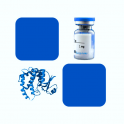
- Remove this product from my favorite's list.
- Add this product to my list of favorites.
Products
Viewed products
Newsletter
 |  |  |  |  |  |

Background
Human coronavirus NL63 (HCoV-NL63) is one of seven known coronaviruses to infect humans. The virus is an enveloped, positive-sense, single-stranded RNA virus which enters its host cell by binding to ACE2. Infection with the virus has been confirmed worldwide, and has an association with many common symptoms and diseases. The spike protein of HCoV-NL63 is a trimer protruding from the viral membrane to engage cellular receptors and mediate viral fusion with host membranes. Each spike trimer contains two large regions: N-terminal S1 responsible for receptor binding and C-terminal S2 responsible for fusion.
Source
Recombinant HCoV-NL63 Spike Trimer, His Tag (SPN-H52H4) is expressed from human 293 cells (HEK293). It contains Phe 16 - Asn 1291 (Accession # Q6Q1S2-1).The recombinant protein is expressed from human 293 cells (HEK293) with T4 fibritin trimerization motif and a polyhistidine tag at the N-terminus.
Predicted N-terminus: Phe 16
Molecular Characterization
This protein carries a polyhistidine tag at the C-terminus.
The protein has a calculated MW of 146.9 kDa. The protein migrates as 200-240 kDa under reducing (R) condition (SDS-PAGE) due to glycosylation.
Endotoxin
Less than 1.0 EU per μg by the LAL method.
Purity
>90% as determined by reduced SDS-PAGE.
Formulation
Lyophilized from 0.22 μm filtered solution in PBS with trehalose as protectant.
Reconstitution
Please see Certificate of Analysis for specific instructions.
For best performance, we strongly recommend you to follow the reconstitution protocol provided in the CoA.
Storage
For long term storage, the product should be stored at lyophilized state at -20°C or lower.
Please avoid repeated freeze-thaw cycles.
This product is stable after storage at:
-20°C to -70°C for 12 months in lyophilized state;
-70°C for 3 months under sterile conditions after reconstitution.
(1) "De novo posttransplant membranous nephropathy after COVID-19 vaccination 9 years after renal transplantation in a patient with polycystic kidney disease"
Fukuda, Yokoyama, Miki et al
CEN Case Rep (2024)
(2) "Discovery of small molecule entry inhibitors targeting the linoleic acid binding pocket of SARS-CoV-2 spike protein"
Prasad, Kadam, Padippurackal et al
J Biomol Struct Dyn (2024)
(3) "Establishment, Optimization and validation of a fluorescence polarization-based high-throughput screening assay targeting Cathepsin L inhibitors"
Zhou, You, Zhao et al
SLAS Discov (2024)
Showing 1-3 of 35881 papers.
Recombinant SARS-CoV-2 (COVID-19) S1 protein, His Tag (MALS verified), 100µg - 507,00 €
Recombinant Biotinylated SARS-CoV-2 (COVID-19) S1 protein, His,Avitag™ (MALS verified), 25µg - 507,00 €
Recombinant SARS-CoV-2 (COVID-19) S protein RBD, Fc Tag (MALS verified),100µg - 507,00 €
Recombinant SARS-CoV-2 (COVID-19) Nucleocapsid protein, His Tag, 100µg - 533,00 €
Follow us